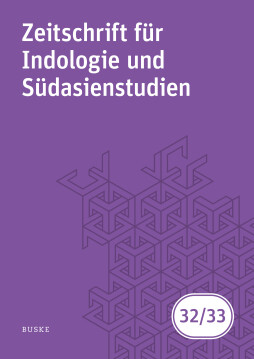
BUCH
Zeitschrift für Indologie und Südasienstudien, Band 32 (2015) / 33 (2016)
Herausgeber: Oberlies, Thomas | Harder, Hans
Zeitschrift für Indologie und Südasienstudien, Bd. 32 (2015) / 33 (2016
2025
Zusätzliche Informationen
Bibliografische Daten
Abstract
Inhalt Tim Felix Aufderheide: Die Bedeutung von abhinidhāna in den Prātiśākhyas Willem Bollée: Hemacandra’s Life of Mahāvīra (Triṣaṣṭiśalākāpuruṣacaritra X) Analysed in Keywords from Helen Johnson’s Translation VI Thomas Oberlies: Appendix: Life and work of Helen M. Johnson Willem Bollée: Addenda et Corrigenda to »Bollée, Willem B., Cultural Encyclopaedia of the Kathāsaritsāgara« Jonas Buchholz: Countering Kampaṉ: C. N. Annadurai’s Critique of the Rāmāyaṇa Deepra Dandekar: Muṃbaī ke Aulīyā: The Sufi Saints Makhdoom Ali Mahimi (Mumbai) and Hajji Malang (Mumbai-Kalyan) in songs and hagiography Per-Johan Norelius: Vaitaraṇī. On Early Hindu Eschatology and Ritual Šarūnas Paunksnis: India Darkly: Dirty Realism and Film Noir in Neoliberal India Jürgen Schaflechner: »The Hindu« in Recent Urdu Horror Stories from Pakistan Sthaneshwar Timalsina: Text as the Metaphoric Body: Incorporation of Tripurā in SaundaryalaharīInhalt Tim Felix Aufderheide: Die Bedeutung von abhinidhāna in den Prātiśākhyas Willem Bollée: Hemacandra’s Life of Mahāvīra (Triṣaṣṭiśalākāpuruṣacaritra X) Analysed in Keywords from Helen Johnson’s Translation VI Thomas Oberlies: Appendix: Life and work of Helen M. Johnson Willem Bollée: Addenda et Corrigenda to »Bollée, Willem B., Cultural Encyclopaedia of the Kathāsaritsāgara« Jonas Buchholz: Countering Kampaṉ: C. N. Annadurai’s Critique of the Rāmāyaṇa Deepra Dandekar: Muṃbaī ke Aulīyā: The Sufi Saints Makhdoom Ali Mahimi (Mumbai) and Hajji Malang (Mumbai-Kalyan) in songs and hagiography Per-Johan Norelius: Vaitaraṇī. On Early Hindu Eschatology and Ritual Šarūnas Paunksnis: India Darkly: Dirty Realism and Film Noir in Neoliberal India Jürgen Schaflechner: »The Hindu« in Recent Urdu Horror Stories from Pakistan Sthaneshwar Timalsina: Text as the Metaphoric Body: Incorporation of Tripurā in Saundaryalaharī


 Publishing Platform by CloudPublish
Publishing Platform by CloudPublish